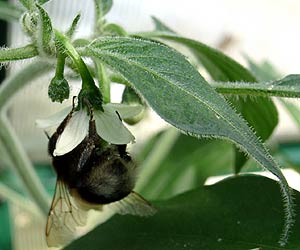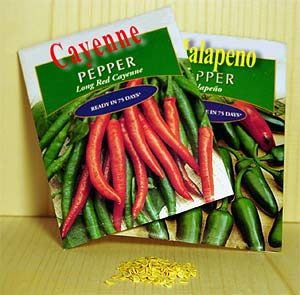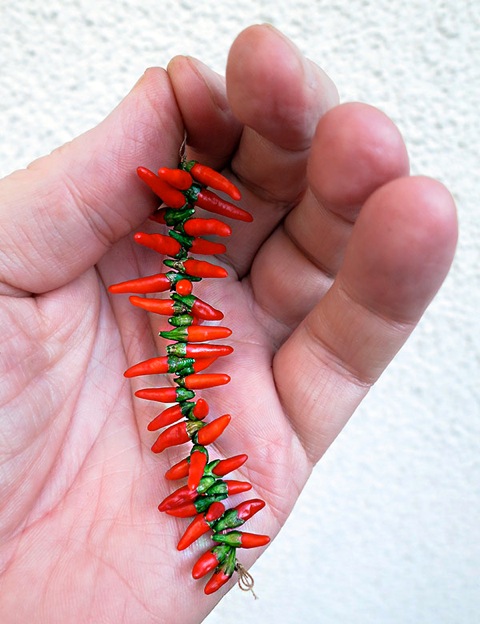Home gardeners often produce unwanted hybrids (out-crosses) because peppers are notorious cross-pollinators. When different varieties are planted close together in the garden, bees and other insects will carry pollen from flower to flower, cross-pollinating them. The pods of the current year’s plants will be true, but the seed in those pods will produce hybrids thereafter.

Like this bumblebee on a serrano flower, insects will carry pollen from flower to flower, cross-pollinating them.
To produce seed that is true to type, individual varieties must be pollinated only by their own pollen. Commercial seed producers avoid cross-pollination by isolating varieties and planting them at least a mile from each other, which is farther than the average bee flies. Home gardeners can produce true seed by isolating peppers from insects and growing them in greenhouses or under netting.
Many pepper gardeners exchange seed with other growers, but this seed may also not grow true to type. Home growers can either ask the sender how the seed was grown, or plant it and see what happens. Gardeners and seed collectors from all over the world send us seed, and the more unusual the variety is, the greater our temptation is to grow it regardless of origin.
Seed produced by seed companies is generally more reliable than home grown seed because the companies try to safeguard the genetic purity of the cultivar. They use a systematic seed-growing process, which begins with crop improvement associations in each state. In the association, a plant breeder responsible for developing a specific variety of pepper or other crop produces small quantities of Breeder Seed. It is multiplied into Foundation Seed, which is controlled by the crop improvement association. The association grows the Foundation Seed to produce Registered Seed, which is sold to seed companies to produce Certified Seed for farmers and the general public.

Commercial seed packages
Large seed companies have their own internal process which mirrors the one used by crop improvement associations. Company plant breeders develop Breeder Seed and Foundation Seed for specific varieties. It is then passed on to company seed production managers, who oversee the growing of Registered and Certified Seed. In some cases, the production of Certified Seed is “farmed out” to independent growers on farms distant from each other to avoid cross-pollination.
Unfortunately, some small seed companies and “cottage” seed industries either do not practice proper isolation techniques or buy their seed from growers who do not. Thus, their seed is undependable, and often yields hybrids. Home gardeners should either question small seed companies about their isolation techniques, or confine seed purchases to the major companies. Always buy seed from a reliable seedsman, one who consistently provides varieties true to type, free from disease, and with a high germination percentage. High quality, fresh seed is dependable; cheap seed is neither dependable nor inexpensive.
Growers should check the seed packet for a germination percentage when buying commercial seed. The federal pepper regulations are: seeds with a germination percentage below 55 percent may not be sold; seeds with a percentage between 55 and 85 percent must have the percentage listed on the packet; and seeds with a germination percentage over 85 percent need not have the percentage listed. If you’d like to know more, check out our series of chile pepper gardening articles.
Photos by Harald Zoschke
Latest posts by Dave DeWitt (see all)
- Enchiladas Verdes con Chile Pasado - 02/08/2023
- Smoked Oysters with Ancho Chile Sauce - 01/13/2023
- Machaca Sierra Madre - 01/11/2023








